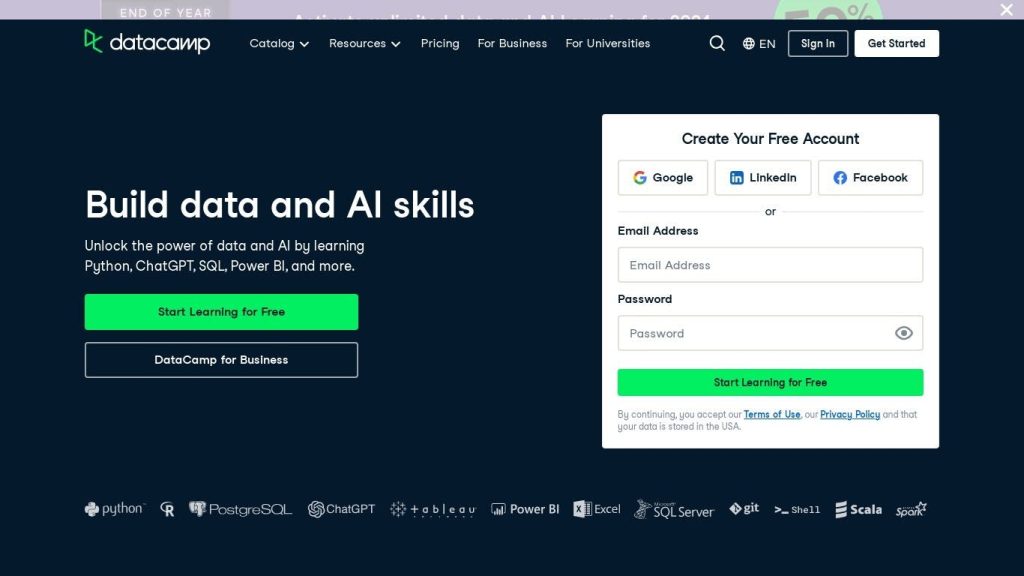What is DataCamp?
DataCamp is an online platform designed specifically for data science and analytics training, with a very broad and diverse market of individual learners and organizations. It offers an all-rounded course catalog for developing skills in data management, analytics, artificial intelligence, and machine learning. The courses provide an immersive environment of hands-on, interactive courses with real-world problem-solving exercises with a browser-based code execution environment for ease of use.
Launched with the aim to democratize data education, DataCamp opens up new ways for people at all skill levels—from beginners to experts—to progress in their professional lives. It delivers courses in some of the most popular technologies like Python, SQL, Power BI, Tableau, Excel, etc. Its strong learning methodology involves assessment at the outset of skills, followed by in-depth learning modules, daily practice challenges, and practical applications in newly acquired knowledge.
Major Features & Advantages of DataCamp
Learn Interactive: Join interactive courses with hands-on exercises and problem-solving activities relevant to real-world scenarios. No Installation Run code directly in your browser for a seamless learning experience. Tailored Learning Paths Take learning paths designed by experts, focused on specific technologies and career goals. DataCamp Signal Use this platform’s assessment tool to find out your data skill level absolutely free.
Certification & Workspace: Learn with certifications and an in-browser workspace for immediate data analysis.
Mobile Learning: Using the mobile app, one is able to access courses and daily coding challenges on the move.
These wide-ranging features make a strong case for learners who seek to develop their skills related to tackling data. The interactive nature of learning material, followed by real-world use cases, helps ensure that users really apply what they have learned.
Use Cases and Applications of DataCamp
DataCamp offers versatile course offerings, making it applicable to various uses across different industries:
-
Professional Development:
Any professional seeking to grow careers in data science and analytics will get full value from DataCamp’s vast course library and practical learning. -
Corporate Training:
More than 2,500 companies trust DataCamp for upskilling teams. It provides a structured learning environment for any corporate training program. -
Academic Use:
DataCamp offers 6 months free to educators and students, which the platform can be using to help carry data science and analytics into every curriculum, from more than 180 countries. Case studies and success stories across industries showcase how DataCamp has been successful in skill building to deliver performance in data-centric job roles.
How to Use DataCamp
-
Sign Up:
Create an account on DataCamp’s website. -
Choose a Course:
Choose from the large library of courses that interest you and your learning goals. -
Hands-on Interactive Learning:
Get into the interactive lessons and exercises. -
Daily Practice:
Learn by solving daily coding challenges. -
Assess and Certify:
Identify your skills using DataCamp Signal and earn certifications to prove your learning.
Tips and Best Practices:
Be consistent; get into the habit of logging in and using the platform frequently. Use the mobile app to learn anywhere, anytime. Practice and apply your skills with the ease of in-browser workspace.
How DataCamp Works
DataCamp has a strong technical base that enables smooth learning in the following ways:
-
Interactive Courses:
In these courses, hands-on coding exercises and interactive lessons engage the learner, and in turn, make learning very effective. -
Browser-Based Coding:
The platform allows one to code and run it directly from a user’s browser. No installation is required. -
Assessment Tools:
DataCamp Signal evaluates the skills of users and gives recommendations of what to learn next.
The workflow is such that one should start by assessing the skill, then taking interactive courses and finally doing daily challenges and applying learned knowledge in real-life situations.
Pros and Cons of DataCamp
Pros:
- Large library of courses on all skills relating to data
- Interactive and hands-on learning style.
- Browser-based coding environment with no installation required
- Mobile learning capabilities for on-the-go education
Potential Drawbacks:
- Some users find the subscription model to be rather pricey
- Advanced learners may feel the need for more in-depth courses
The feedback from users is mostly appreciative of the hands-on approach of the platform, covering almost everything; some of them would want to see additional advanced courses, though.
Conclusion about DataCamp
DataCamp is the leading platform for data science and analytics education, covering all courses with associated practical learning tools. The interactive approach of the course gives users hands-on experience so learners apply their new skills effectively in real-world scenarios. While this subscription cost might become a headache for some, it’s pretty much worth your money if you look at the content and learning methodology that the platform has.
This may also include creating advanced courses in the future and further enhancing more features on its platform to accommodate more diverse learners.
DataCamp FAQs
What is DataCamp?
DataCamp is an interactive learning platform offering online courses to users in order to acquire data and AI skills.
What are the available skills to learn on DataCamp?
You can learn Python, SQL, Power BI, Tableau, Excel, and other data-related skills on DataCamp.
How does DataCamp facilitate learning?
DataCamp contains interactive courses, assessments, daily practice challenges, and real-world problem-solving exercises.
Has DataCamp built trust with businesses for data and AI training?
More than 2,500 companies use DataCamp; it is trusted by 80% of the Fortune 1000 for upskilling teams.
Does DataCamp provide free access to educators and students?
DataCamp provides 6 months of free access to classrooms. It is used in more than 180 countries.










